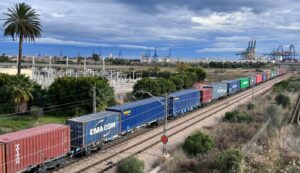
- In the first half of the year, more than 87 trains per week have been mobilised, compared to 83 in the same period in 2022
- Between January and June 2023, a total of 2,180 trains have already run through the Port of Valencia
- Both the number of containers moved by rail has increased by 8% and the total number of goods has risen by 11%
- The average length of the trains has been 498 metres by 493 metres in 2022. The number of wagons has grown by 10% to 45,311 units
- The number of carriages moved on the railways in this period was 30,642, four times more than in the first half of 2022
València, 11 August 2023 – The Port Authority of Valencia (APV) remains firm in its strategic commitment to promote the mobility of goods by rail. It is an essential objective in its commitment to the sustainability of its area of influence. The train continues at full speed in the Port of Valencia, as the figures for the first half of this year show: 2,180 trains -an average of 87 per week-, 45,311 wagons, 498 metres in average length, 116,792 TEU (standard 20-foot container), 30,642 cars or 1,154,072 tonnes of goods. All these figures are higher than the same period in 2022. Efficiency, environment, intermodality, operability or city-port are some of the actions that are boosted with these numbers that endorse the synergy between maritime and rail traffic of the logistics activity developed by Valenciaport.
Thus, between January and June of this year, a total of 2,180 trains entered or left the Port of Valencia, with a weekly average of 87 compared to 83 in the same period last year. There have even been weeks where there have been almost a hundred convoys. “The railway is a key element in the structure of movements of the Port of Valencia, as the data show. Our objective is to continue increasing this traffic quota, betting on the train, the long-distance lines and the improvement of the infrastructures of our inland network. A commitment that not only translates into the Valencian precinct but also includes the Port of Sagunto with works that are progressing at a good pace to provide this precinct with a direct rail service,” said the president of the APV, Joan Calabuig.
Every week there are more trains, longer, with more wagons and carrying more goods and containers. This can be seen in the APV data for January-June 2023. The average length of the trains was 495 metres compared to 493 metres last year. The total number of TEUs (20-foot standard containers) reached 116,792, 8% more than in the same period of the previous year, that is, 8,556 more containers. With regard to goods, the total traffic entering or leaving the Port of Valencia by train was 1,154,072 tonnes, an 11% increase compared to the first half of 2022. To this end, a total of 45,311 wagons have been mobilised, representing an increase of 10%. It should also be noted that in this period the number of cars that have been managed through the railway has been 30,642, four times more than last year.
Madrid and Zaragoza, main markets
Of the total of goods with destination/origin Valenciaport, 7 out of 10 enter or leave from Madrid, a key place that will be reinforced with the railway motorway that will link the Port of Valencia with Madrid. This is followed by products from the area of Bilbao, Zaragoza and Valladolid. With regard to automobiles, 65% come from Zaragoza and 12% from Valladolid.
Rail: key to Valenciaport’s environmental strategy
The APV’s objective for the coming years is to continue to increase the use of the train in freight traffic arriving and departing from Valenciaport, hence the importance of undertaking the necessary actions to adapt rail accessibility. One of the most imminent actions is the start-up of the first Spanish rail motorway that will link the Valencian precinct with Madrid, an initiative on which the APV is already working together with ADIF and the company Tramesa.
Along these lines, Valenciaport is making investments to take advantage of the synergy between maritime and rail transport in order to promote competitiveness and contribute to the reduction of CO2 emissions. Specifically, over the next few years, investments of close to 240 million euros are planned to promote accessibility and improve Valenciaport’s rail network. These actions are aimed at the remodelling of the railway network in the Port of Valencia, the electrification of tracks, the adaptation of the network to the European gauge, the railway access to the Port of Sagunto or the improvement of the Valencia-Teruel-Zaragoza line, among others. The aim is to increase the importance of the railway in freight transport.

